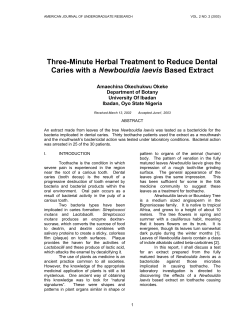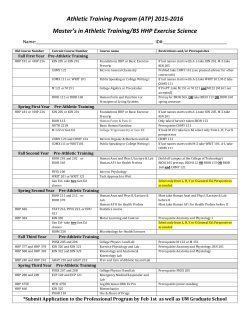
HHP: LITERATURE AND MEASUREMENTS Csaba Németh , Louis Argüello Castillo , László Friedrich
Journal of Hygienic Engineering and Design Original scientific paper UDC 663/664-027.31 HHP: LITERATURE AND MEASUREMENTS Csaba Németh1*, Louis Argüello Castillo2, László Friedrich2, Péter Póti3, Csaba Balla3 Capriovus Ltd., Dunasor 073/72 hrsz., H-2317 Szigetcsép, Hungary Corvinus University of Budapest, Ménesi út 45., H-1118 Budapest, Hungary 3 Szent István University, Páter Károly út 1., H-2100 Gödöllő, Hungary 1 2 e-mail: nemeth.csaba@capriovus.hu * Abstract There are numerous new technologies whose implementation in the food industry is hampered by the fact that people hesitate to invest in expensive systems which they cannot be sure will work, or at least are questionable in terms of a given product. Until recently preservation by HHP, high hydrostatic pressure, was such a technology, and still is today in some branches of the food industry. Investigations were conducted to answer the question of whether the literature, the laboratory, and the industrial (or at least pilot plant) measurements and results agree with each other. We compared the literature data with two HHP systems which were significantly different in terms of treatment capacity, but their efficiency in killing microbes was studied under the same treatment parameters. Our results show that in nearly all cases, only minimal differences exist between the data in the literature and measurements taken on the two appliances. Key words: HHP, Food preservation, Data comparison. 1. Introduction There are numerous new technologies whose implementation in the food industry is hampered by the fact that people hesitate to invest in expensive systems which they cannot be sure will work, or at least are questionable in terms of a given product. Until recently preservation by HHP, high hydrostatic pressure, was such a technology, and still is today in some branches of the food industry. Investigations were conducted to answer the question of whether the literature, the laboratory, and the industrial (or at least pilot plant) measurements and results agree with each other. We compared the literature data with two HHP systems which were significantly different in terms of treatment capacity, but their efficiency in killing microbes was studied under the same treatment parameters. Our results show that in nearly all cases, only minimal differences exist between the data in the literature and measurements taken on the two appliances. HHP or high hydrostatic pressure is one of the “gentle” food preservation methods, as it does not use heat. In high hydrostatic pressure technology, food products are preserved by being subjected to between 100 and 1000 Mpa hydrostatic pressure. In HHP treatment, food products are vacuum sealed in flexible packages and placed in liquid. Hydrostatic pressure is applied quickly and evenly (isostatically) according to the Pascal method [1], thus neither the size nor the shape of the container play a role in the effects of the pressure treatment [2, 3, 4]. The advantage of this method, in contrast to traditional heat treatment, is killing microbes and inactivating enzymes without the undesirable effects of high temperature. This method does not change the product’s taste, texture, or color and is less harmful to its nutritional value. Product freshness is better preserved as well. Additives may be reduced or eliminated completely. Moreover, with this method, new technological and functional properties may be developed [5, 6]. Even in the area of liquid products, HHP technology is being applied with increasing frequency (Table 1, [7]). Until now, rather small capacity laboratory equipment has been used for testing the many advantageous properties of high hydrostatic pressure treatment of foods. The aim of our experiments was to determine the degree of ability of laboratory and pilot plant systems to kill microbes; and further to discover how those results compare with the data in the literature. Table 1. Examples of high-pressure processed products commercially available in different countries Country Japan France Mexico Year 1993 1994 2000 Product Rice wine Citrus juice Citrus juice and concentrate 147 Journal of Hygienic Engineering and Design Lebanon Portugal 2001 2001 Czech Republic 2004 USA Northern Ireland 2005 2006 New Zealand 2009 Fruit juices Apple and citrus flavor fruit juices Broccoli, apple, beet, and carrot juices Fiber fruit juices Apple, wild strawberry, and ginger juices Colostrum 2. Materials and Methods 2.1 HHP treatment Our experiments were carried out according to the parameters in published articles (matrix, treatment time, pressure during treatment, and microbes). The Budapest Corvinus University Department of Refrigeration Technology and Animal Products own two HHP systems: one laboratory type (Stansted Food Lab 900, plunger press system) and one pilot plant type (RESATO FPU 100-2000) Thus it was possible to apply measurements derived from the literature, using similar parameters, on two separate machines. 2.2 Microbiological tests We intended to examine each change in total viable cell count, and the death of each important microbe specific to a given product. For our tests, we prepared inoculate with microbes grown on slant agar, after which we infected the samples with amounts which produced measurements similar to those found in the literature. 2.3 Preparation of Salmonella enteritidis, inoculation of samples, and colony counting The Salmonella enterica subsp. enterica, serotype enteritidis NCAIM B2052 species used in the experiments was obtained from the National Collection of Agricultural and Industrial Microorganisms (NCAIM). We prepared inoculate from microbes grown during 24 hours on meat broth slant agar, after which we added two streaks of preparation to each 10mL of sterile peptone water (the diluting liquid), and then this was administered in various amounts to the samples. Following HHP treatment, dilution plating was completed with selective XLD and Harlequin Salmonella agar. Plates were incubated for 48 hours at 37 0C, after which the growth of colonies was determined with a colony counter. 2.4 Preparation of Listeria monocytogenes, inoculation of samples, and colony counting The inoculation and colony counting of the samples with L. monocytogenes was carried out similarly to Sal148 monella enteritidis, except that Brain Heart agar was used for the slant growth, and plate pouring was done with PALCAM agar. 2.5 Preparation of Escherichia coli, inoculation of samples, and colony counting Inoculation and colony counting of samples with E. coli was similar to that of Salmonella enteritidis, but plate pouring was carried out with ChromoCult Coliform agar. 2.6 Preparation of Staphylococcus aureus, inoculation of samples, and colony counting Inoculation and colony counting of samples with S. aureus was completed in a similar way to Salmonella enteritidis, but here plate pouring was done with Baird Parker agar. 2.7 Preparation of Pseudomonas aeruginosa, inoculation of samples, and colony counting The inoculation and colony counting of P. aeruginosa samples happened in a similar way to that of Salmonella with the exception that Cetrimide agar was used for plate pouring. 2.8 Determination of aerobic viable cell count A series was prepared from both the treated and untreated (uninfected) samples. They were diluted at a ratio of 10 : 1 with sterile water, after which we used Nutrient agar plate pouring to determine microbe levels in the samples. Plates were incubated for 48 hours at 37 0C, and a colony counter was used to determine how many colonies had appeared. 3. Results and Discussion It can be seen from our results that levels of microbe death in certain foods varied only slightly between the laboratory and the (pilot) plant, while they agreed with the data in the literature (Table 2). Slight variations in the viable cell count test could be attributed to deviations in the micro flora composition; variations in the test of given phyla may derive from differences of serotype; moreover, it can be said that the homogeneity of the food used as matrix was imperfect (water and fat content, etc.). Journal of Hygienic Engineering and Design Table 2. Comparison of literature data and our results p t LAB P.P. LIT. REF. (enteritidis) meat broth 345 600 3,3 3,1 3,0 [8] (typhimurium) phosphate buffer 350 600 0,9 1,1 1,2 [9] boiled ham 400 600 2,0 1,7 1,9 [10] (enteritidis) ham 500 600 6,5 6,4 7,1 [11] broth 500 600 8,2 7,8 8,0 [12] puffer 375 900 2,2 2,4 2,0 [13] boiled ham 400 600 2,5 2,2 2,4 [10] turkey breast 400 60 0,7 0,6 0,5 [14] ham 450 600 3,0 2,9 3,6 [15] turkey breast 500 60 4,1 3,7 3,8 [14] liquid whole egg 300 600 0,8 0,8 0,5 [16] (O157-H7) broth 345 600 7,7 7,5 8,1 [8] liquid whole egg 450 600 3,3 3,6 3,5 [16] puffer phosphate buffer 500 300 7,5 7,6 7,3 [17] phosphate puffer 600 300 8,7 9,1 8,3 [17] sheep’s milk 345 600 4,2 3,7 4 [8] víz water 400 1800 5,0 5,5 5,2 [18] sheep’s milk 450 1800 3,0 3,2 1,8 [19] milk 600 900 2,2 1,9 2,0 [13] turkey meat 600 900 3,2 2,9 3,0 [13] sheep’s milk 250 1800 7,0 7,1 6,6 [19] (aeruginosa) water 300 1800 5,1 4,8 4,6 [18] (fluorescens) water 300 1800 4,5 4,9 4,7 [18] broth 345 600 4,5 4,7 4,0 [8] corned beef 500 300 3,4 3,1 2,0 [20] chicken liver 200 1200 1,5 1,8 1,3 [21] sliced pineapple 270 900 1,5 1,6 1,6 [22] liquid egg 300 600 2,4 2,7 2,3 [23] sliced pineapple 340 900 2,9 3,3 3,0 [22] ham in brine 600 360 3,0 2,6 2,7 [24] Salmonella Listeria monocytogenes Escherichia coli Staphylococcus aureus Pseudomonas Viable cell count p : treatment pressure, Mpa. t : treatment time, s. LAB : lg (N/N0) - value in a laboratory apparatus. P.P. : lg (N/N0) [ value in a pilot plant apparatus. LIT : lg (N/N0) - value from literature data. REF : literature which was used, and which belongs to the LIT. 149 Journal of Hygienic Engineering and Design It is apparent from the data that results taken from the literature and laboratory systems allow us to make conclusions about how the material’s microbiological condition will change during processing in a plant. 5. References Figure 1 shows literature data (the measurements which we tried to reproduce) and correlation to results from pilot plant systems. It is clear that there is close correlation, (r2 = 0.96). The r2 value was 0.99 for Salmonella; for Listeria 0.92; for E. coli 0.98; for S. aureus 0.77; for P. aeruginosa 0.96; and 0.87 for viable cell count. [2] San Martín M. F., Barbosa-Cánovas G. V., Swanson B. G. (2002). Food processing by high hydrostatic pressure. Critical Reviews in Food Science and Nutrition, 42, 6, pp. 627-645. [1] Dalmadi I., Farkas J. (2006). Fruit preparations for the preservation of high hydrostatic pressure (in Hungarian). Élelmezési Ipar, 60, 12, pp. 262-264. [3] Farr D. (1990). High pressure technology in the food industry. Trends Food Sci. Tech. 1, 1, pp. 14-16. [4] Lechowich R. V. (1993). Food safety implications of high hydrostatic pressure as a food processing method. Food Technol. Chicago, 47, 1, pp. 170-172. [5] Rico D., Martín-Diana A. B., Barat J. M., Barry-Ryana C. (2007). Extending and measuring the quality of fresh-cut fruit and vegetables: a review. Trends Food Sci. Tech. 18, 7, pp. 373-386. [6] Oey I., Lille M., Loeya A. V., Hendrickxa M. (2008). Effect of high-pressure processing on colour, texture and flavour of fruit- and vegetable-based food products: a review. Trends Food Sci. Tech., 19, 6, pp. 320-328. [7] Knorr D., Froehling A., Jaeger H., Reineke K., Schlueter O., Schoessler K. (2011). Emerging Technologies in Food Processing. Annual Reviews in Food Science and Technology, 2, 2, pp. 203-235. [8] Alpas H., Kalchayanand N., Bozoglu F., Ray B. (2000). Interactions of high hydrostatic pressure, pressurization temperature and pH on death and injury of pressure-resistant and pressure-sensitive strains of foodborne pathogens. Int. J. Food Microbiol., 60, 1, pp. 33-42. [9] Tholozan J. L., Ritz M., Jugiau F., Federighi M., Tissier J.P. (2000). Physiological effects of high hydrostatic pressure treatments on Listeria monocytogenes and Salmonella Typhimurium. J. Appl. Microbiol., 88, 2, pp. 202-212. Figure 1. Correlation between the literature and the industrial results 4. Conclusions - In summary, we can say that the microbe-reducing effect of HHP treatment - for the purposes of a processing plant - can well be calculated from literature data and from laboratory measurements. - This very advantageous characteristic is due to the fact that with HHP technology, the same pressure bears on every point of the treated material simultaneously, regardless of the volume or size of the product. Acknowledgement Our research materials were produced with generous contributions from the KMR_12-1-2012-0181 research and development project titled “Support of market-oriented development ability in the central Hungary region.” We are very grateful for this. 150 [10] Aymerich M. T., Jofré A., Garriga M., Hugas M. (2005). Inhibition of Listeria monocytogenes and Salmonella by natural antimicrobals and high hydrostatic pressure in sliced cooked ham. J. Food Prot., 68, 1, pp. 173-177. [11] Yuste J., Pla R., Mor-Mur M. (2000). Salmonella Enteritidis and aerobic mesophiles in inoculated poultry sausages manufactured with high-pressure processing. Letters in Applied Microbiology 31, 5, pp. 374-377. [12] Mackey B. M., Forestiere K., Isaacs N., Stenning R., Brooker B. (1994). The effect of high hydrostatic pressure on Salmonella Thompson and Listeria monocytogenes examined by electron microscopy. Lett. Appl. Microbiol., 19, 6, pp. 429-432. [13] Patterson M. F., Quinn, M. Simpson R. K., Gilmour A. (1995). Sensitivity of vegetative pathogens to high hydrostatic pressure treatment in phosphatebuffered saline and foods. J. Food Protect., 58, 5, pp. 524-529. [14] Chen H. (2007). Temperature assisted pressure inactivation of Listeria monocytogenes in turkey breast meat. Int. J. Food Microbiol., 117, 1, pp. 55-60. [15] Morales P., Calzada J., Nunez M. (2006). Effect of high pressure treatment on the survival of Listeria monocytogenes Scott A in sliced vaacum-packaged iberian and serrano cured hams. J. Food Prot., 69, 10, pp. 2539-2543. Journal of Hygienic Engineering and Design [16] Ponce E., Pla R., Sendra E., Guamis B., Mor-Mur M. (1998). Combined effect of nisin and high hydrostatic pressure on destruction of Listeria inocua and Escherichia coli in liquid whole egg. Int. J. Food Microbiol., 43, 1-2, pp. 15-19. [17] Hauben K. J., Bartlett D. H., Soontjens C. C., Cornelis K., Wuytack E. Y., Michiels C. W. (1997). Escherichia coli mutants resistant to inactivation by high hydrostatic pressure. Lett. Appl. Microbiol., 63, 3, pp. 945-950. [18] Arroyo G., Sanz P. D., Préstamo G. (1999). Response to high-pressure, low-temperature treatment in vegetables: determination of survival rates of microbial populations using flow cytometry and detection of peroxidase activity using confocal microscopy. J. Appl. Microbiol., 86, 3, pp. 544-556. [19] Trujillo A. J., Capellas M., Saldo J., Gervilla R., Guamis B. (2002). Applications of high-hydrostatic pressure on milk and dairy products: a review. Innovative Food Science and Emerging Technologies, 3, 4, pp. 295-307. [20] Rubio B., Martinez B., Garcia-Gachán M. D., Rovira J., Jaime I. (2007). Effect of high pressure preservation on the quality of dry cured beef „Cecina de Leon”. Innovative Food Sci. Emerg. Technol., 8, 1, pp. 102-110. [21] Tuboly E. (2009). Effects of high hydrostatic pressure technology applications in some of the microbiological status of food quality and other characteristics (in Hungarian). Corvinus University of Budapest, Budapest, Hungary, PhD thesis. [22] Aleman G. D., Farkas D. F., Torrws J. A., Wilhelmsen E., Mcintyre S. (1994). Ultra–high pressure pasteurization of fresh cut pineapple. J. Food Prot., 57, 10, pp. 931-934. [23] Németh Cs., Dalmadi I., Mráz B., Friedrich L., Zeke I., Juhász R., Suhajda Á., Balla Cs. (20012). Effect of high pressure treatment on liquid whole egg. High Pressure Res., 32, 2, pp. 330-336. [24] Garriga M., Grébol N., Aymerich M. T., Monfort J. M., Hugas M. (2004). Microbial inactivation after high-pressure processing at 600 MPa in commercial meat products over its shelf life. Innovative Food Science and Emerging Technologies, 5, 4, pp. 451-457. 151
© Copyright 2025












